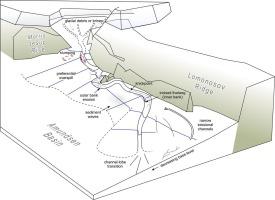Marine Geology ( IF 2.9 ) Pub Date : 2021-07-22 , DOI: 10.1016/j.margeo.2021.106571 Kai Boggild , David C. Mosher

|
Turbidity currents are fundamental marine sedimentary processes that deliver sediments from continental margins to deep ocean basins. They develop and maintain deep-sea channels that act as principal conduits for this sediment delivery. While turbidity current channels are frequently considered as analogous to river channel systems, there are distinct differences in the mechanisms that govern their formation. This is particularly true at high-latitudes, where glacial margin processes and Coriolis effects have direct consequences on the characteristics of channel-forming turbidity currents. Understanding the latitudinal controls that influence the structure of these channels is thus a key objective of this study.
The geomorphology of the glacial-fed NP-28 Channel in the Amundsen Basin of the Arctic Ocean, the highest-latitude deep-sea channel on Earth, is assessed. Compilation of available bathymetry shows that the channel follows a low-gradient, low-sinuosity path roughly paralleling the base of Lomonosov Ridge. The channel has a broad cross-section comparable to other glacially-fed and tributary-fed deep-ocean channel systems. High-resolution subbottom profiles reveal intrachannel terraces and an incised channel thalweg that were likely formed through erosion by traction-dominated currents; stratified levees and sediment waves were likely deposited by overbank flows. Coriolis deflection of channel-filling currents is evident from consistent levee asymmetry along the entire channel path. Within the channel, the channel floor geometry suggests local dominance of both Coriolis and centrifugal forces at the base of the channel; the latter in particular where the channel is deflected by external bedrock. Overall, channel morphology is largely consistent with existing models of Coriolis force effects on turbidity currents at high latitudes. This influence of Coriolis force, in addition to the presumed glacial style of the sediment input and bedrock interaction with the channel path, are considered the major factors that affected channel morphology.
中文翻译:

极纬度的浊流:北冰洋阿蒙森盆地 NP-28 通道的案例研究
浊流是基本的海洋沉积过程,它将沉积物从大陆边缘输送到深海盆地。他们开发和维护深海通道,作为这种沉积物输送的主要管道。虽然浊流通道通常被认为类似于河道系统,但在控制其形成的机制上存在明显差异。在高纬度地区尤其如此,在那里冰川边缘过程和科里奥利效应对形成通道的浊流特征有直接影响。因此,了解影响这些通道结构的纬度控制是本研究的一个关键目标。
评估了北冰洋阿蒙森盆地(地球上纬度最高的深海通道)的冰川补给 NP-28 通道的地貌。现有水深测量的汇编表明,该通道遵循一条低梯度、低曲率的路径,大致平行于罗蒙诺索夫海脊的底部。与其他冰川补给和支流补给的深海航道系统相比,该航道具有广阔的横截面。高分辨率的海底剖面揭示了通道内阶地和一个切开的通道 thalweg,它们可能是由牵引主导的水流侵蚀形成的;分层的堤坝和沉积波很可能是由溢流沉积而成。从沿整个通道路径一致的堤坝不对称性可以明显看出通道填充电流的科里奥利偏转。通道内,通道底部的几何形状表明,在通道底部,科里奥利力和离心力在局部占主导地位;后者尤其是在通道被外部基岩偏转的情况下。总体而言,通道形态与现有的科里奥利力对高纬度浊流的影响模型基本一致。科里奥利力的这种影响,除了假定的沉积物输入的冰川风格和基岩与通道路径的相互作用,被认为是影响通道形态的主要因素。



























 京公网安备 11010802027423号
京公网安备 11010802027423号